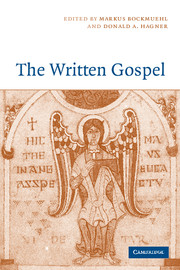Book contents
- Frontmatter
- Contents
- List of contributors
- List of abbreviations
- Introduction
- PART I BEFORE WRITING
- PART II WRITING THE FOUR GOSPELS
- 5 Who writes, why, and for whom?
- 6 How Matthew writes
- 7 How Mark writes
- 8 How Luke writes
- 9 How John writes
- 10 Beginnings and endings
- PART III AFTER WRITING
- Appendix: Graham Stanton's publications
- Bibliography
- Index of ancient sources
- Index of authors
6 - How Matthew writes
Published online by Cambridge University Press: 07 December 2009
- Frontmatter
- Contents
- List of contributors
- List of abbreviations
- Introduction
- PART I BEFORE WRITING
- PART II WRITING THE FOUR GOSPELS
- 5 Who writes, why, and for whom?
- 6 How Matthew writes
- 7 How Mark writes
- 8 How Luke writes
- 9 How John writes
- 10 Beginnings and endings
- PART III AFTER WRITING
- Appendix: Graham Stanton's publications
- Bibliography
- Index of ancient sources
- Index of authors
Summary
What exactly did Matthew have on his table when he composed the gospel? One wonders. Strewn upon his tabletop would no doubt have been a copy of some form of Mark, possibly another document or a collection of written traditions (Q), and papyri and other items upon which were inscribed bits of the Jesus tradition, sayings, miracle stories, parables, etc. Additionally, he would have had scrolls of OT texts (e.g., MT, Aramaic, LXX or some other Greek translation of Isaiah, Jeremiah, Psalms, etc.) or, at the very least, testimony collections. But to limit his resources to texts alone is to bias Matthew's composition. As Ong, Kelber, Gerhardsson and, more recently, Dunn remind us, such a view results from the technologizing of the word that is the cultural residue of Gutenberg's press. A purely textual focus is restrictive and misrepresents the culture of the first century. Of equal or, if Papias is correct, greater importance would have been the communal Jesus narratives that were recounted as part of his community's corporate story (oral tradition). Furthermore, one wonders where the creative energy and impulse to write derived from and whether he wrote in isolation or others in his community somehow participated. Would communal worship have affected his writing (e.g., the Lord's Prayer in 6.9–15)? Furthermore, to what extent might the social setting of the Matthean church have influenced the gospel's content and tone? All told, the question of how Matthew wrote contains within it a complexity that is staggering.
- Type
- Chapter
- Information
- The Written Gospel , pp. 116 - 134Publisher: Cambridge University PressPrint publication year: 2005
- 2
- Cited by



